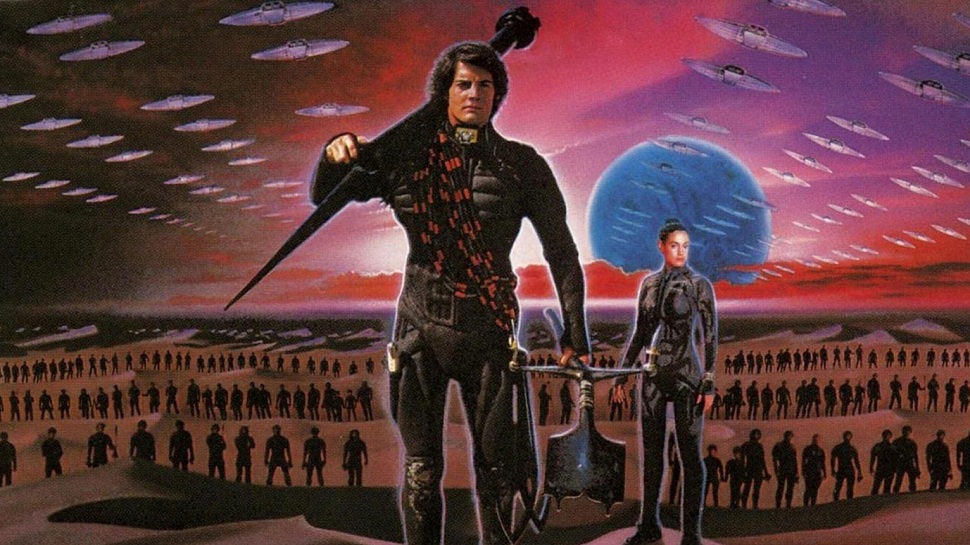Later tonight, The Culture Tsar is going to a special showing of David Lynch’s Dune, the 1984 adaptation of Frank Herbert’s classic science fiction novel. Dune has been The Culture Tsar’s favorite novel for decades now, with nothing much else coming even close to it. There’s really no other book that provides the same combination of imaginative sci-fi worldbuilding and adventure with compelling questions about politics, society, ecology, economics, and religion.
Lynch’s Dune adaptation is…well…interesting. Judging it on a spectrum of “good” to “bad” seems to miss much of what makes it worth talking about almost 35 years since its release. To get that superficial detail out of the way quickly, though, Dune is not a good film. The pacing is awful, the story is all over the place, the voiceover narrations are jarring, the performances are uneven, and the character motivations are opaque at best. As a piece of filmmaking, Dune is kind of a mess.
But nobody remembers or cares about that because Lynch’s Dune is an amazing work of visionary cinema. In retrospect, it’s unbelievable that a major Hollywood studio spent millions of dollars on this movie and released it hoping to score a big hit. Dune is weird, dangerous, and utterly fearless in most of its choices. The bizarre Jules Verne meets Renaissance Italy art design sets the film apart from contemporary sci-fi epics like Star Wars and Star Trek while being a strangely appropriate fit for the baroque society of Herbert’s Imperium. Lynch’s nightmarish vision of House Harkonnen’s Giedi Prime homeworld nicely embodies Herbert’s themes of corruption and resource exploitation in addition to giving us one of cinema’s most memorable and grotesque villains. The competing organizations of the Dune universe, the Spacing Guild, the Mentats, the Bene Gesserit, stand out as distinctive groups deeply enmeshed in their own institutional history and culture. There’s a sense of “otherness” about them that feels very true to Herbert’s book, even if the portrayals themselves are rather far afield from the book’s aesthetic. Lynch instinctively understood that film is a visual medium. While the book could take the time to explain the history and practices of the Spacing Guild, the film could accomplish the same thing with visual design. One look at the Spacing Guild and the viewer understands that it’s far more than just a group of powerful people with a monopoly on interstellar travel.
Not all of these choices work (although The Culture Tsar would like to register his dissent with popular opinion by saying that Sting is great as Feyd Rautha). Fantastic art design stands alongside some rather shoddily conceived ideas (the god awful ornithopters and the haz-mat worker lookalike Sardaukar soldiers come to mind), but on the whole, Lynch’s unique visualization of Herbert’s world is a success. Even the biggest divergence from the book, the “weirding module” sonic weapons, kind of work. Most of the desert scenes are great, giving the film a sense of scale that would be sorely missing in the later television adaptation (the 2000 Sci-Fi Channel mini-series, which was also flawed, but in completely different ways).
Honestly, the movie’s biggest problem is that it tried to be too faithful to Herbert’s novel. If Dune were being adapted today, it would probably wind up as a ten episode HBO series rather than a single film. There’s just too much information to pack into a two and a half hour film without fatally compromising some aspect of the novel. Lynch’s adaptation strips the story down to the absolute minimum and sacrifices a lot of the setting’s depth in an effort to make everything fit. As an adaptation, it doesn’t really come close to succeeding. The story is moving so fast and the characters so beholden to the demands of the plot that we really don’t become invested in anything. A lot happens in the movie, but you don’t really care about any of it, especially on the initial viewing when you’re just trying to keep up with what’s going on. The 2000 Sci-Fi Channel adaptation does a better job of making you care and giving more depth where needed, but it’s hampered by extremely uneven production values and some frankly mediocre writing and design. It’s worth noting that Sci-Fi Channel’s 2003 sequel mini-series, Children of Dune, is fantastic and easily the best film adaptation of Herbert’s work (despite a painfully cringeworthy Susan Sarandon performance). While bringing Dune to the screen is difficult, we have clear evidence that it’s not impossible.
At any rate, The Culture Tsar is eager to see Lynch’s compelling, if flawed, adaptation on the big screen tonight. Even when the movie showcases its worst features, he can always take comfort in its fantastic score. In keeping with the theme of not much about Lynch’s Dune making sense, the soundtrack was composed by the rock band Toto.
It’s one of the great soundtracks of the 1980s. Go figure…





